Automatic N-Scale Signals for DC Track
There are a number of ways to add signals to a model railroad. I’ve described the more complex method I’ll be using with my DCC-based layout elsewhere, but this page is to describe the simpler systems that can be used on a DC-powered layout. For more about the prototype, see the Railway Signals and Signaling page, and for some example photos see the Example Signals page.
I’m interested in this as I’m planning to use these on a simple DC-powered table-top “tram” (light rail) layout. But I’m also curious about how easy it would be to adapt these to use at least the signal heads with a DCC system.
For DC layouts a number of vendors make simple signals if you want to do your own control systems, but I’m going to focus on the two Japanese manufacturers of plug-and-play Japanese-prototype signals, Kato and Tomix. To be fair, a basic two- or three-color signal in Japan looks much the same as a vertical-target US-prototype one. Unfortunately the Atlas signals use a circular target, and thus don’t fit the Japanese prototype.
Both of these signals only work with DC, as they monitor the polarity of the track to determine direction, and only turn red when a train passes the signal from front-to-back. Since DCC constantly has both polarities, the control electronics won’t work properly. Also, while some have reported that DCC does not harm these signals, they are designed for 12V, and DCC systems may have voltages considerably higher although basic ones are often 14V. Signals on a layout or module that is sometimes used with DCC may fail after exposure to such voltage.
Both Kato and Tomix essentially work on a timer system. A track sensor detects a metal wheel passing, and sets the signal to red. Subsequent wheels in the same train reset the timer (as long as they’re metal). When the last metal wheel passes the signal waits a time, then turns yellow (or for Tomix’s larger signals some intermediate color) and after a similar delay cycles to the next color, eventually reaching green. Each signal acts in isolation, and there’s no communication between them, and no sensing of “block occupancy” beyond wheels passing the signal. A train parked just past the signal won’t prevent it from (very unrealistically) turning green.
Kato
Kato makes a very simple three-aspect signal (20-605) with Red, Yellow and Green LEDs. The signal is attached to the side of a 124mm segment of track, but the base of the signal itself is quite small and will fit between parallel tracks.
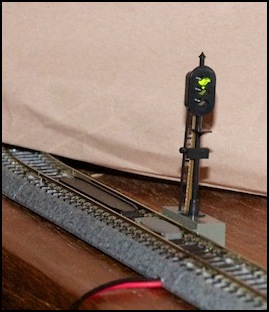
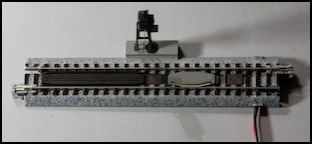
Kato Signal - Working and top-down view
Although the part number is the same, the signals sold by Kato U.S.A. place the signal to the right of the track, following U.S. “right hand running” practice. The signals sold in Japan place the signal to the left of the track (and also appear from photographs to be made of white plastic with a black target, instead of all-black as are the U.S. models). The signal is not reversible (the base has cut-outs that only work one way and the signal mast is soldered to the circuit board below it anyway).
Kato makes a Automatic Signal Power Supply (24-844) that operates on either 12V DC (from a Kato pack) or 17 V AC (typical of U.S. power packs) and provides three 12V DC outputs (one signal per output). To connect to a Kato pack, an additional Accessory Adapter (24-829) is required per Signal Power Supply. For more than three signals, additional accessory adapters can be linked, each driving one power supply and up to three signals. The signals are rated to draw 50 mA, which suggests they use bulbs, and also places a fairly low limit on the number a power pack could support.
The Kato documentation says that the signals take 3 seconds to cycle from Red to Yellow, and another three to Green. I have two signals, and both take more like 4.5 seconds per step. The cycle time is fixed regardless of train speed.
Tomix
Tomix makes signals in two-aspect, three-aspect, and two versions of four-aspect heads:
- Two Aspect (Red, Green): Stop and Proceed
- Three Aspect (Red, Yellow, Green): Stop, Caution and Proceed
- Four Aspect (Red, Yellow, Green and Yellow-over-Yellow). This adds a “Restricted Speed” indication (25 kph), which they call “Alert”.
- Four Aspect (Red, Yellow, Green and Yellow-over-Green). This adds a “Reduced Speed” indication (50-75 kph depending on railway), which they call “Deceleration”.
- Five Color, Four Aspect (Red, Yellow, Green and Flashing Yellow over Green). This adds a speed limitation of 105 kph. This signal has been sold out for some time.
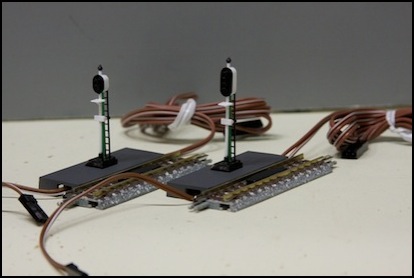
Two and Four-lamp signals
Note: Yellow alone means “Caution”, and indicates speeds of 40-55 kph, depending on the railway. Green typically means “maximum track speed” except on high speed lines where it means 130 kph, and a Green-over-Green signal, requiring a six-lamp head, means “track speed”; Tomix doesn’t presently make a six-lamp model signal.
As with the Japanese Kato signals, the signal mast is located to the left of the track facing an oncoming train, appropriate for Japanese practice but not for typical U.S. practice.
One nice thing about the Tomix signals is that they’re attached to the base via a plug. I’m not sure there’s any practical use, but they are easy to remove.
The signals are intended to be daisy-chained off the power pack’s TCS output, so each has a short “plug” cord to connect to the next in line. There’s a receptacle underneath to tuck the short core away if it’s not used.
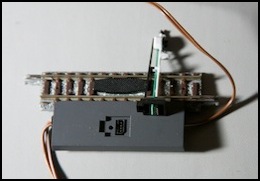
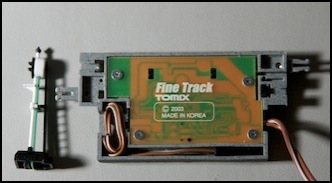
Detached Signal and stowed cord
The Tomix signals are rated to draw 10 mA, which pretty much guarantees that they’re using LEDs. They apparently draw 30 mA when “setting operating mode”, but it’s not clear if that’s a start-up power draw or the amount needed when changing aspect. It may actually only be needed when the behavior of the signal is altered (there’s a way to do this by turning power on and off in a pattern; I’m still working out just what the options for that are).
One downside to the Tomix signals is that the block under the signal is as wide as the track it’s attached to, and as a result the signal cannot be placed between parallel tracks. This doesn’t matter in typical Japanese uni-directional running, but limits the utility of the signal for other kinds of operations.
Electrically, this system is similar to Kato’s. It connects to the “TCS” output on a Tomix power pack (a 12V DC supply), and a number of signals can be daisy-chained (up to the limit of the TCS output, which isn’t clearly stated on my power pack). In addition to the direction/timer mechanism used by Kato, there is supposedly a variable-speed timer based on sensing track voltage, so that the signal waits longer after a slow-moving train passes. I didn’t see that initially, but later testing showed a relationship (which could be either track voltage or measuring the delay between two subsequent passings of the signal; I need to test more).
What I initially saw was that the color cycles in about 2.5 - 3 seconds to the next color. This means the two-color signal goes from red to green in three seconds, and the four-lamp signal goes from red to green in nine seconds. This is rather too fast for reasonable speed operation, as you can see by the sequence below (the two signals are about 3’ apart):
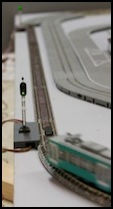
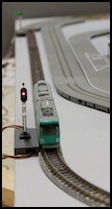
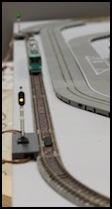
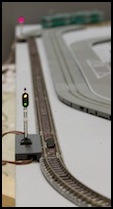
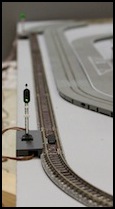
With the tram moving at a somewhat faster than normal speed (about 100 kph) it hasn’t even reached the next signal, about 90 scale meters away, before a following move is given a yellow signal.
However, additional testing showed that the signals “learned” the faster speed after the train had gone around the loop a couple of times, and adjusted so that the train was about 3/4 around the loop before the four-aspect signal cycled back to green (the two-aspect signal cycled faster in both cases).




